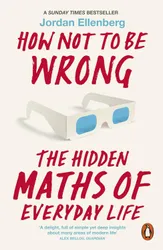At the beginning of this book, Ellenberg states that he’s going to explore the “simple and profound” aspects of mathematics; those topics that seem simple on the surface but which provoke more troubling questions when thought about more deeply. It’s not dissimilar to other mathematical books I’ve read, such as What’s The Use and Thinking Better, in that it covers a range of mathematical subjects, with real-world applications. But this book stands out for the author’s willingness to explore the less certain aspects of mathematics, and to delve into more philosophical areas.
The author warns us at the start of the book that we are going to get our hands dirty, and the book does contain lots of numbers, formulae and charts. I followed along with parts of it, and took the author’s word for other parts without doing the calculations myself.
One theme of the book, that is both interesting and a little unsettling, is that there things that don’t really have a single right answer. Instead, we define something to be correct in order to resolve the ambiguity. So there are some infinite series presented in the book where arguments can be made that they have various different values, but mathematicians have had to settle on defining them to have a certain value. And in the chapter on elections, many cases are presented where different voting systems would give different results, but where all of those results can be argued to be against the will of the people voting.
I enjoyed the sections about professional lottery syndicates, and the approaches they took to playing certain lotteries profitably. Along the way, the author brings in the ideas of Claude Shannon and Richard Hamming on error correcting codes, the use of perspective in art, and non-Euclidean geometry. These mathematical tangents often seem at first to be irrelevant to the topic of the chapter, but Ellenberg always brings it back to the matter at hand, and the tangents turn out to be crucial for understanding the chapter.
I enjoyed the explorations of some of the darker and less certain sides of mathematics. Ellenberg paints mathematicians as being less rational than perhaps other books do. I particularly enjoyed the suggestion that David Hilbert’s choice of footwear continues to influence mathematicians:
I once met a historian of German culture in Columbus, Ohio, who told me that Hilbert’s predilection for wearing sandals with socks is the reason that fashion choice is still noticeably popular among mathematicians today.
One part of the book talks about statistics, in particular related to the interpretation of scientific results. In this topic, it covers some of the same ground as Science Fictions, Bad Science and The Art of Statistics. (I should mention that, with the exception of Bad Science, all these other books I’ve mentioned were written after How Not To Be Wrong.)
The writing style in this book is witty and fun to read. It made me feel less certain about some of the mathematical foundations of our world that I took for granted, and I enjoyed the different perspective that it offers.
